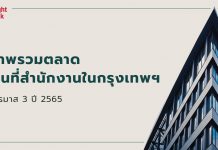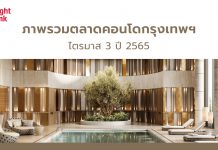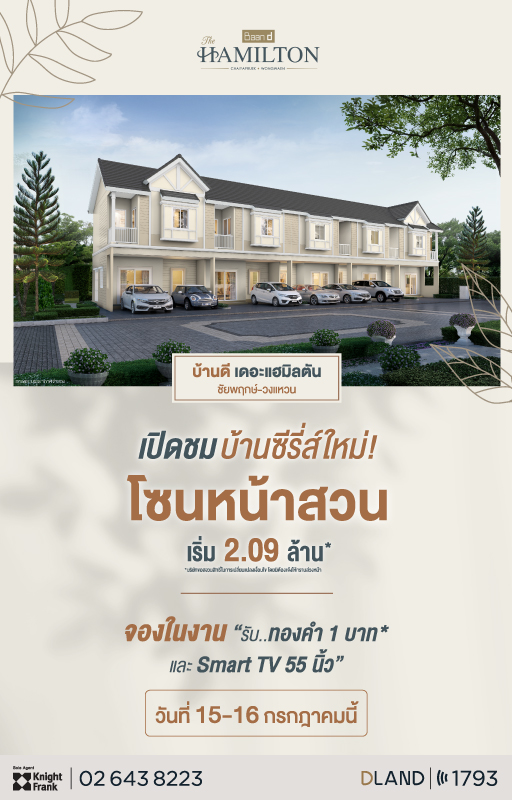Mr. Carlos Martinez, Director of Research and Consultancy, Knight Frank Thailand said, in 2021, the Covid-19 pandemic continued to disrupt the hospitality industry that has caused a massive drop in the number of visitors to Bangkok since March 2020. The total number of inbound foreign visitors plummeted by 91% YoY to circa 560,000. Yet, this figure increased by 174% YoY in the second half of the year mostly as a result of the ease of travel restrictions under the ‘Test & Go’ scheme during the last two months of the year.

At the beginning of the second half of 2021, the Thai government launched a pilot program called ‘Phuket Sandbox’, as a first attempt to ease travel restrictions and resume the battered tourism industry in Thailand. However, Thailand reached a peaked of infections a couple of months after, in August 2021, with over 20,000 cases per day, postponing the country’s reopening and impacting the traveler’s confidence. In November 2021, Thailand introduced a more ambitious quarantine-free scheme named ‘Test & Go’. There were 346,763 international arrivals under this program, just before the government temporarily suspended it on 21 December amid concerns over the spread of the Omicron variant.
In 2021, 51% of the total number of international visitors were from Europe, followed by East Asia (21%) and the Americas (13%).

Supply and Demand
As traveling restrictions remained in place during most of 2021, demand for hotel accommodation continued at its lowest levels. The average occupancy rate of five-star hotels in Bangkok was at 21%, 6 p.p. lower than that in 2020. The number of both domestic and foreign tourists remained low because of the combination of several pandemic outbreaks, multiple clusters of Covid-19, and the late vaccine rollout. The inoculation of Thai residents started in late February 2021, and as of the end of 2021 circa 64% of the total population was fully vaccinated with two doses.


The hotel occupancy rate improved in the second half of 2021 to 22%, driven by the increase in domestic demand supported by the subsidized tourist campaign named ‘We Travel Together’, and the relaxation of entry requirements to foreign visitors under the ‘test & go’ scheme in November 2021. Yet with weak demand and a large number of hotel rooms in the city, the Average Daily Rate (ADR) of luxury hotels dropped by 34% YoY to THB 2,949.
The year 2021 ended without any new hotel openings in the luxury segment. Given the poor market outlook, hotels with plans to open in 2021 were delayed. New luxury hotel openings are expected to add circa 3,000 keys in 2022 if new hotels in the pipeline go ahead.
Yet, several hotels in the upscale and midscale segments opened in 2021, including Glow Sukhumvit 71 (108 rooms), Oakwood Hotel & Residence Bangkok (142 rooms), and Maitria Hotel Rama 9 (209 rooms), Shama Yenakart Bangkok (136 rooms), The Quarter Silom (160 rooms), The Quarter Ploenchit (160 rooms), Holiday Inn Express Bangkok Ratchada (220 rooms), JAL City Bangkok (324 rooms), and the Courtyard by Marriott Suvarnabhumi Airport (617 rooms).
The total number of luxury hotel rooms remained unchanged at 20,555 since 2020. The major concentration of rooms is located in the Early Sukhumvit area with 39%, followed by the Lumpini area (24%), the Riverside area (17%), and Silom/Sathorn area (14%).
Outlook
The country’s reopening under the ‘Test & Go’ scheme in November 2021 had a positive response. The number of monthly international visitors increased to six digits just before the suspension of the scheme by the risk of the Omicron variant in late December 2021.
The recovery of the hospitality industry relies on the ease of travel restrictions in Thailand and its main market sources which remain unpredictable. The high level of vaccination rate globally seems not to be enough to stop the spreading of the virus. We expected the see a bounce-back of tourism activities by late 2021, but things turned for the worse; first with the Delta wave, and later with the high transmissible variant Omicron. At the beginning of 2022, several countries reintroduced travel restrictions and postponed border reopening plans. Nevertheless, Omicron has been associated with mild to moderate symptoms, that might lead to less restrictive measures to help cut down the spreading.
Subject to the resume of the ‘Test & Go’ scheme in Thailand, the number of international tourism in 2022 is likely to pick up surpassing that in 2021, initiating the recovery of the tourism sector, with a gradual increase in the number of international tourists mainly from traditional feeder markets such as Europe, North America, and the Middle East. However, it is unlikely to reach significant levels in the number of tourists without China, the main tourism market feeder, that keeps its zero-Covid policy discouraging Chinese tourists from traveling abroad. The Bank of Thailand forecasts 5.6 million foreign arrivals in Thailand in 2022, mostly during the second half of the year.
Even though the pandemic is not controlled yet, and new variants may arise after Omicron, we can be more optimistic in 2022 due to the high inoculation rates, and government experience in handling the situation when compared to the beginning of the pandemic in early 2020. Ease of travel restrictions and simple travel rules are key factors to restore travelers’ confidence and drive the recovery in the tourist industry in 2022.














